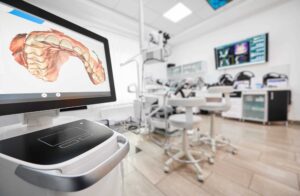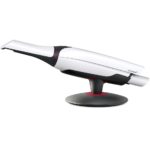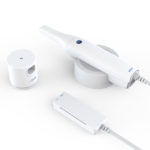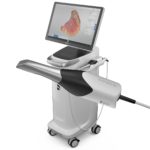Table of Contents
Technology has changed the shape of virtually every industry on the planet, including dentistry. Thanks to the advances of modern technology, dentistry has significantly evolved, and in the 21st century, dentists can provide their patients with better care than ever before. Not only has modern technology made the work of dentists a whole lot easier, but it has also increased patient satisfaction, as well as their overall happiness.
One of the most significant technological advances in modern dentistry is the intraoral scanner. This device is used to capture optical, dental impressions, and ever since it was introduced, the dentistry profession has dramatically improved and become more diversified than ever before.
Intraoral scanners save dentists time and allow them to see more patients, they have improved the accuracy of dentistry as these scanners reduce the incidence of manual errors, they allow for better treatment options and outcomes, improve patient comfort, and they save dental practices, insurers, and patients money.
Given the numerous benefits they provide, manufacturers have taken notice, and to offer the highest quality care for patients and improve dentistry practice, there are several different intraoral scanners on the market today. While the choice is certainly a good thing, figuring out which scanner to use can seem like a daunting task. It goes without saying that you want to choose the best option for your specific needs and the needs of your patients, but which one is that?
This guide reviews some of the most popular Dental intraoral scanners on the market: 3Shape TRIOS 4, Medit i500, and Cerec Primescan. With the information presented in this guide, you should be able to determine which scanner will best suit your needs and the needs of your patients so that you can improve the quality of care you provide and the results that you offer.
What is an Intraoral Scanner?
Before we review the above-mentioned products, we want to provide you with an overview of this type of dental technology. Intraoral scanners (IOS) are devices that are designed to capture direct optical impressions. These devices provide extremely accurate dental measurements in compact and highly secure digital information files that can be transmitted quickly to laboratories.
Once the laboratories receive the files, they can use the measurements to make the process of fabricating prescriptive corrective appliances much easier, faster, and more cost-effectively than ever before; plus, the appliances are extremely high-quality and yield much better results.
Intraoral scanners can be used by general and cosmetic dentists to create various corrective dental appliances, including veneers, crowns, bridges, and even dental implants. Orthodontists can use them, too, as a way to diagnose dental issues and offer their patients the highest quality treatments possible. Not only do they make the job of dental health experts a lot easier and more efficient, but they also benefit patients. They’re a lot more comfortable than antiquated methods of taking optical impressions, they take a lot less time, and the results are much more reliable.
With so many benefits, intraoral scanners have vastly improved the practice of dentistry. Therefore, it comes as no surprise that many dentists are now using this technology and are seeing much better results, which both dental health care professionals and their patients certainly appreciate.
 Intraoral scanners are based on a probe that’s about the size of a toothbrush. The probe is run across the surface of the teeth and scans and records optical impressions.
Intraoral scanners are based on a probe that’s about the size of a toothbrush. The probe is run across the surface of the teeth and scans and records optical impressions.
The data, including the size, the shape, and the exact placement of patients’ teeth, is scanned and recorded with incredible precision. The probes are very lightweight, comfortable, and are outfitted with several useful features, such as auto-focus, freeze-frame, an anti-fog lens, wide-angle viewing, and auto power-off.
Some intraoral scanners are stand-alone, self-contained technologies, and others are connected to a separate computer. As the dental health professional passes the probe over the patient’s teeth, the system shows what it sees on either a computer monitor or a standard television screen.
Additionally, it digitally records the date, which the practitioner can review later and share with staff and colleagues (for example, a general dentist can share the data with an orthodontist). The data can also be sent to a facility that can fabricate the necessary corrective appliances.
Since dental health professionals can assess the digital images can view the data as soon as it is collected, it allows practitioners to confirm that the information is correct and that all necessary information has been collected. Compared to antiquated methods used to model the teeth and gums, which required several weeks to assess and prolonged the amount of time it took for dental health practitioners to hear back from the fabrications labs if there are any issues in the process of making molds for corrective appliances.
Intraoral Scanner Comparison Criteria for Evaluation

Now that you have a good idea of what an intraoral scanner is, it’s time to jump into our reviews of three of the most popular models: 3Shape TRIOS 4, Medit i500, and Cerec Primescan. However, before we do, we want to share the criteria that we used to evaluate and compare these technologies.
We compare the most crucial criteria of intraoral scanners, including:
- Speed
- Flow
- Size
- Ease of use
- Price
- Subscription requirements (it’s important to note that there are different packages available to purchase
The above criteria are the key factors that dictate the effectiveness of each intraoral scanner. By comparing these features, you will be able to determine which technology will best suit your needs, the needs of your patients, and that would be the best addition to your practice.
What is the Best Intraoral Scanner? Intraoral Scanner Comparison Reviews
So, let’s jump in and explore the 3Shape TRIOS 4, the Medit i500, and the Cerec Primescan intraoral scanners.
1. 3Shape TRIOS 4 ($26,999.00)

3Shape is a Danish company that was founded in 2000. The manufacturer began producing hearing aids and developed a digital method to take impressions of the ears to create hearing aid shells. The manufacturer’s success changed the hearing aid industry’s shape, and in 2004, they shifted to the dental industry, as many dental health professionals showed interest in their technologies.
3Shapes objective was to make a full transition from analog techniques to digital technologies in dentistry, just like they did in audiology. They created three intraoral scanning devices, including the TRIOS 3 Basic, the TRIOS 3, and their latest addition, the TRIOS 4. Like the TRIOS 3 Basic and the TRIOS 3, the TRIOS 4 is very fast, highly reliable, and is very easy to use.
TRIOS 4 Scanning Speed
As far as scanning speed goes, the TRIOS 4 is incredibly fast. While the speed isn’t a vast improvement over its predecessor, the TRIOS 3; however, there are some improvements in the rate of speed. In fact, it’s one of the fasts intraoral scanners currently available on the market.
It offers a straightforward yet highly intuitive user interface, and the protocol used for scanning is virtually the same as the scanning protocols of all intraoral scanners. A full arch scan can be achieved in less than 45 seconds, and the software generates very vivid high-definition color images.
Regarding starting and stopping scans, the TRIOS 4 picks right up where it left off. After the initial scan, interproximal areas require some touch-ups to ensure that all necessary data is collected.
TRIOS 4 Flow
Flow is an essential aspect of dental health care, and one of the most notable benefits of intraoral scanners is that they maximize flow. The TRIOS 4 joins together the most state-of-the-art scanning technologies with groundbreaking dual caries detection, allowing it to offer the continuous flow of essential knowledge that better benefits dental practitioners, and thus, patients. The open ecosystem and partner integrations between dental health care professionals and prescription corrective appliance facilities. It even offers manufacturing options with 3D printers and milling machines.
Size
One of the most notable features of the 3Shape TRIOS 4 is the size. The scanner heads are smaller than the scanner heads of other intraoral scanners on the market, including the CEREC Primescan; however, it is bigger than the scanner head on the Medit i500. Weighing in at just 345 grams (when wired) or 375 grams (when outfitted with a wireless batter), the TRIOS 4 is very lightweight; but, it should be noted is light. It is considered a mid-range scanner in terms of weight.
Ease of Use
The 3Shape TRIOS 4 is available in two options: the pod (a plug and play design) and the Move. While both are easy to use, the Move offers the best ease of use, thanks to the ergonomic design; it’s actually one of the most ergonomic cart scanners currently on the market. It is effortless to maneuver. The height and the angle of the screen can be easily adjusted to achieve the best view, so it can be used while the practitioner is standing or sitting (most scanner cars are made to be used while the practitioner is sitting).
The elongated wheelbase, coupled with the adjustable arm, allows the scanner screen to be pulled over the dental chair and positioned right in front of the patient while the scans are being done. This allows for improved engagement with the patient while also making it easier for a more comfortable scanning experience for both the patient and the practitioner.
The main start and stop button is positioned on the top of the scanner, making it incredibly easy to access. It also features an inbuilt gyrometer that makes it possible to move scans around so they can be viewed and so that the software can be navigated without the need to touch the screen.
The TRIO 4 features a robust PC that was thoughtful designed to keep lag at a minimum while handling scans. It also comes complete with a 3Shape stylus touch pen, which is certainly a handy feature.
Lastly, the TRIOS 4 is the only wireless intraoral scanner available, making the entire process of scanning a more seamless and even more enjoyable experience; for example, the practitioner won’t have to give a second thought to taking a full arch scan of a patient. Regarding run-time, the scanner runs for about 20 minutes with no lag or connectivity issues; however, we do have to point out that the battery life could be improved, as it tends to run out of power quickly, but it can be plugged into a power source.
TRIOS 4 Price
While the TRIOS 4 features robust technologies, is easy to use, and takes incredibly accurate scans, there is a downside: it is one of the most expensive intraoral scanners on the market. That really isn’t a surprise, as such an advanced design and such state-of-the-art technologies cost a premium. While there are more affordable scanners on the market, you get what you pay for, as the saying goes. If ease of use, enhance flow, and extreme accuracy are important to you, then the price of the TRIOS 4 will certainly be worth the investment.
Subscription Requirements
3Shape offers two different services packages for the TRIOS 4: basic and subscription. If you opt for the subscription package, you will be able to take advantage of the following:
- Authorized support
- Software upgrades, including the latest releases with the most recent developments, including tools, libraries, and workflows
- Training options, including hands-on training events and lectures that are conducted by 3Shape professionals
- 25 percent discounts on additional seats and the 3Shape Academy Training offered at a 3Shape facility
- A 5-year warranty and replacement service with the purchase of the E4 or D2000 scanners
2. Medit i500 ($10,500.00)

One of the most recent additions to the scanner industry is the Medit i500. The manufacturer claims that it’s the easiest way for practitioners to make the transition into digital dentistry, as it does not only offer some pretty useful features but is also one of the most affordably priced intraoral scanners on the market.
Medit i500 Speed
The Medit i500 offers fast speeds. It has to be held closer to the surface of the teeth and the gums while scanning than other intraoral scanners, such as the TRIOS 4; however, the protocol is the same used for all IOS scanners. It generates very vivid high-definition color images. Also, to offer fast speeds, the i500 easily relocates its position when scanning is paused and has to be restarted.
Medit i500 Flow
Like the TRIOS 4, the Medit i500 combines most state-of-the-art scanning technologies with groundbreaking dual caries detection, which allows for the constant flow of vital information for dental practitioners, and thus, patients. The open ecosystem and partner integrations between dental health care professionals and prescription corrective appliance facilities.
Medit i500 Size
The i500 is outfitted with a minimal scanner head; the scanner head is smaller than the TRIOS 4 and the CEREC Primescan. Weighing just 280 grams, it’s also very lightweight, lighter than the TRIOS 4.
Medit i500 Ease of Use
The small scanner head and the lightweight design certainly adds to the ease of use of the Medit i500. It is only available in a pen-grip configuration. It isn’t wireless, which some practitioners may find bothersome; however, given the cost-effective price tag, if you’re making the transition to digital dentistry, it is certainly usable.
The design is simplistic. It features two buttons: the on/off button is located on the bottom, and the start/stop button is located on the top. It lacks the rubberized textured grip that the TRIOS 4 offers, so be aware that you might have to focus more on gripping. With that said. However, ergonomic and lightweight design makes it easy to hold, so you shouldn’t have any issues.
The i500 is a plug-and-play design, meaning that it needs to be connected to a computer or laptop via a USB cord. If you are using it with a laptop, the laptop will need to be plugged in the entire time, which can make for many wires; however, if you create a dedicated workstation, you should be able to manage the wires. The software offers an impressive variety of tools that can be used to analyze and manipulate scans, and new tools are always being added.
Medit i500 Price
The most notable feature of the i500 is the price tag, as it’s one of the most economically-friendly scanners on the market. It actually costs tens of thousands less than other products. You will have to pay for additional scanning heads; however, the price is still competitive despite this.
Subscription Requirements
Medit just launched subscriptions this year, and they are designed to offer additional cloud storage. You can add more storage to the Meditlink Link software (which has 10 Gb of free storage), but you have to pay for that extra space. The manufacturer does offer a free subscription if you remain within the realm of its free cloud storage.
3. CEREC Primescan ($19,999.00)

Manufactured by Dentsply Sirona, the CEREC Primescan was made to “redefine your standards of outstanding accuracy and speed…”. It can be used for all dental treatments, ranging from a single dental implant to a complete arch. It is designed to be fast, accurate, and easy to use.
Primescan Speed
In terms of speed, the CEREC Primescan is exceptionally fast; in fact, it’s the fasts scanner currently available on the market. Thanks to the Pixel Sensor, it can consolidate more than 50,000 images per second and offers fast data processing. In addition to being fast, it’s also one of the most fluid and lag-free scanners on the market. You can even control the depth of scanning up to 20mm, which allows for highly accurate scans.
Primescan Flow
Like the TRIOS 4 and the Medit i500, the CEREC Primescan by Dentsply Sirona joins together the most advanced scanning technologies available with the most revolutionary caries detection capabilities. Combined with several revolutionary features, this scanner allows for a constant flow of vital information for dental practitioners. Thus, patients—the open ecosystem and partner integrations between dental health care professionals and prescription corrective appliance facilities.
Primescan Size
Of the three intraoral scanners, the Primescan has the largest head size. It measures 15 mm by 15 mm, making it larger; however, the larger size allows it to capture images with impressive detail. It does so quite easily and helps preserve even more data, which translates to improved accuracy. Due to the larger size, it is also slightly heavier than the i500 and the TRIOS 4. However, despite the bigger dimensions and heavier weight, it does not seem to impede usability and comfort.
Primescan Ease of Use
Thanks to the improved field of view, the Primescan can capture larger areas and require fewer sweeps while delivering pinpoint precision. The increased depth field of up to 20 mm makes the image capture more constant and doesn’t seem to cause any breaks.
The touch screen has been updated from 4:3 to 16:9, which allows for better views, and you can also access and control the software on the touchscreen. The position of the screen can be adjusted and tilted, which allows for easier use. The start/stop and on/off buttons are easy to access, as well. All of these elements combined to make the Primescan very easy to use; in fact, we’d venture to say that it’s one of the easiest intraoral scanners to use on the market.
Primescan Price
The CEREC Primescan by Dentsply Sirona is moderately priced; the cost falls between the i500 and the TRIOS 4. It offers more features and more robust software than the i500, so the higher price is understandable. The technologies it offers and ease of use allow it on-par with the TRIOS 4 (though not as robust), so it offers similar results at a more affordable price.
Primescan Subscriptions
There are subscription options available for the Primescan. Options include a broad portfolio of more than 25 integrated software options, access to software support, in-person remote training options, and personalized software solutions for the unique needs of your practice.
Conclusion
All three intraoral scanners are high-quality, easy to use, and offer a range of features that improve dentistry practice for practitioners and patients. The right one for you depends on your specific needs; however, whichever one you choose, an IOS is sure to bring your practice into the digital age.
Dr. John C Chao is an Orthopedic Surgery Specialist in Atlanta, Georgia. He graduated with honors from University Of Texas Southwestern Medical School At Dallas in 2007. Having more than 12 years of diverse experiences, especially in ORTHOPEDIC SURGERY,

